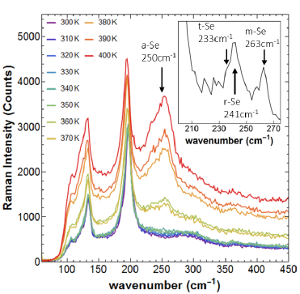
Photon-induced selenium migration in 1T-TiSe2
- Details
- Published on Friday, 21 September 2018 00:00

Transition metal dichalcogenides (TMDs) exhibit series of unique electronic properties ranging from charge density wave order to superconductivity. 1T-TiSe2 is a member of TMD family of compounds that exhibits charge density wave order. Due to its specific structural and electronic properties, TiSe2 has been considered as an alternative to graphene electronics in thermoelectric applications and as a cathode material in batteries. Characterization of defects in layered TMDs is essential for widespread application of TMDs.
Recently, we concluded Raman spectroscopy and microscopy studies on single crystal TiSe2 aimed at investigating the dynamics of thermal and photon-induced defects associated with the diffusion of selenium to the surface. To understand the relevant temperatures and activation energies for selenium diffusion, we conducted systematic experiments by varying both laser beam power and temperature. We observed additional phonon peaks near 250cm-1 at the laser-irradiated regions that are consistent with the formation of amorphous and nanocrystalline selenium on the surface. Studies of the threshold temperature and laser intensity necessary to initiate selenium migration to the surface show an activation barrier of 1.55 eV for this process. The extrapolation of the onset temperature of the photon-induced damage shows that the process of selenium vacancy nucleation could start at temperatures as low as 440K without any photon assistance.
These results on the thermal- and photon-induced nucleation of selenium vacancies and the diffusion of selenium to the surface of TiSe2 have broader implications for both the fundamental studies of TiSe2 as well as its potential practical applications.
